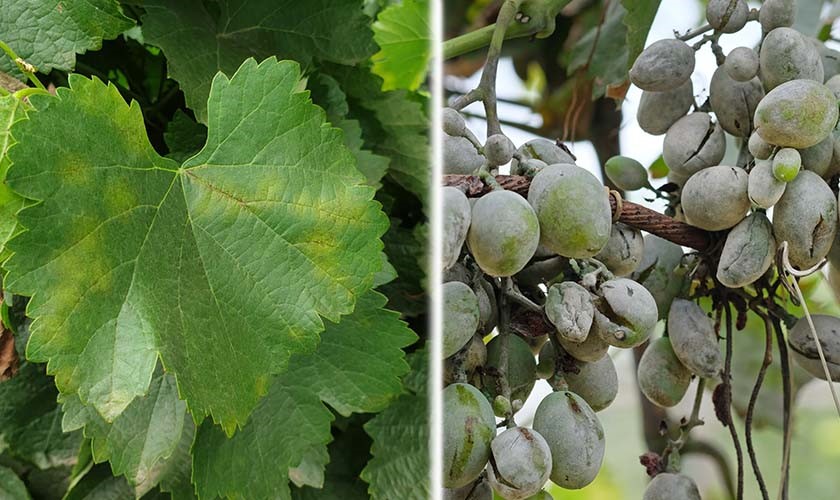Powdery mildew and downy mildew of the grapevine: why, how, and when to apply treatments

Attack of powdery mildew and downy mildew in the grapevine
Powdery mildew and downy mildew are two of the most common diseases affecting the grapevine. They are caused by phytopathogenic fungi that develop rapidly in environmental conditions that favour their growth. These fungi affect the quality of grapes, complicate winemaking processes and can, in some cases, result in significant financial losses in harvests.
Climatic factors are decisive in the emergence of these agents and for this reason it is essential to act rapidly to prevent and stop the propagation of powdery mildew and downy mildew of the grapevine. Certain ranges of temperature and relative humidity are conducive to the emergence of these diseases although the most severe powdery mildew infections in grapevines occur in dry climates while downy mildew is a disease that needs cool, wet conditions to develop.
Powdery mildew of the grapevine (Erysiphe necator, Uncinula) develops at temperatures of 20-27°C and conditions of relative humidity of between 40 and 80%. Temperatures above 30ºC hinder its development and above 35º its germination is inhibited.
By contrast, downy mildew of the grapevine (Plasmopara viticola), develops ideally in environments with rainfalls of more than 10 L/m2 and temperatures above 12°C. Downy mildew starts to develop in spring and the risk of the disease is even greater if a warm and humid spring is followed by a very rainy summer.
Both powdery mildew and downy mildew of the grapevine attack all the plant's organs, with clearly visible signs on leaves, stems, and clusters. In the case of powdery mildew, for example, infection of clusters can occur at the particularly delicate time of flowering, with the appearance of a characteristic whitish powder.
In the case of downy mildew of the grapevine the most obvious symptoms are foliar oil spots that have a whitish, cottony appearance on the underside of the leaf. If the downy mildew attack is severe it can cause leaves to shrivel and drop off the vine or even result in the partial or total loss of berries.
Treatments to combat downy mildew and powdery mildew of the grapevine
At the time of the year when the disease develops, marked by the presence of the previously described environmental conditions, vines need to be treated against the disease. Fungicides can be divided into the categories of preventive and curative treatments depending on their characteristics and the time when they are applied. There are also agronomic cultural practices that can help prevent the fungus from appearing (green pruning, irrigation control, espalier training...).
Seipasa has a catalogue of biofungicide solutions developed based on its natural technology model. Basei 2C is a biofungicide with curative action for controlling powdery mildew of the grapevine (Uncinula necator). Thanks to its sodium bicarbonate it produces a drying effect. Carbonate and bicarbonate ions dissociate on the leaf area and produce direct osmotic pressure that damages the cell walls of conidia and hyphae, causing them to collapse and die.
Basei 2C formulation includes surfactants that aid its dilution and adherence to plants. In addition, this biofungicide for controlling powdery mildew of the grapevine leaves no residues on grapes and does not interfere with the winemaking process, and therefore does not affect the wine's organoleptic qualities.
Septum is another of Seipasa's biofungicide options for the control of powdery mildew (Erysiphe necator) and downy mildew (Plasmopara viticola) of the grapevine. One of the main strengths of this product lies in its formula in which the key molecules from Equisetum extract are isolated in a balanced proportion to guarantee maximum effectiveness.
Based on its contents of phenols, flavonoids, saponins and silicic acid, Septum has a preventive action, providing plant cells with structural stability and mechanical resistance to the propagation of fungi as well as triggering a physiological defence response.
This biofungicide for controlling powdery mildew and downy mildew of the grapevine also has a curative action as it brings about the breakdown and dehydration of fungal tissue. Septum, developed based on Seipasa's natural technology model, leaves no residues on grapes and is compatible with organic production strategies, integral pest management and conventional production systems.
Seipasa's third option for controlling downy mildew (Plasmopara viticola) and powdery mildew (Erysiphe necator) of the grapevine is Basei LEC. This biofungicide has a preventive action, forming a natural lipid layer that covers the plant's organs. Its high reactivity to pathogens helps to deactivate them and stops propagation of fungi on grapevines.
Due to the prevalence and negative consequences of powdery mildew and downy mildew of the grapevine it is essential to be alert to weather conditions and any signs that plants may show in order to act quickly and effectively. Prevention is always a farmer's best ally.

